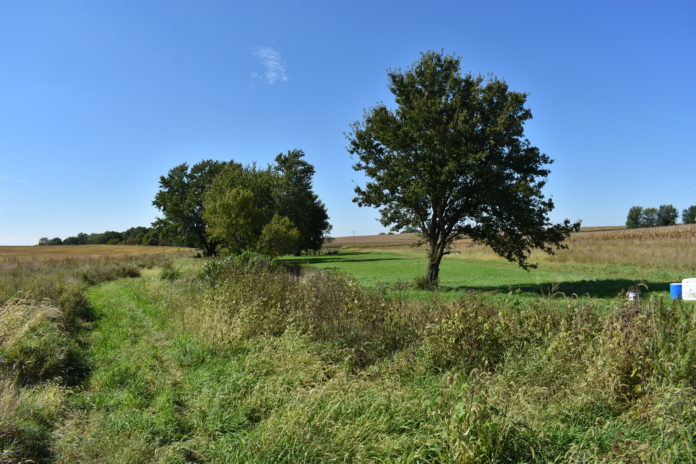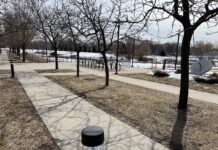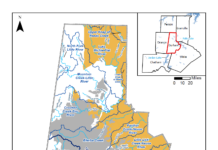By Andrea McEachran, M.S.
Nitrate exported from agricultural lands contributes to surface water quality impairment. Subsurface drainage, often referred to as tile drainage, is commonly used in the midwestern United States to improve row crop production by lowering the water table. However, due to leaching, tile drainage often has high nitrate concentrations. Nitrate export from tile drainage has been identified as a major contributor the Gulf of Mexico hypoxic zone,3 the largest hypoxic zone in the U.S.
Tile drainage can be treated with saturated riparian buffers (SRBs) (Figure 1), an edge-of-field conservation practice.6 The tile main is intercepted with a control structure and the drainage is diverted through a perforated distribution pipe, located approximately parallel to the stream. The drainage then seeps out of the pipe and flows as shallow groundwater toward the stream. A weir in the control structure artificially raises the water level in the buffer, increasing the flow rate and promoting denitrification. Denitrification is the primary nitrate removal mechanism in an SRB4 and the rate is greatest in the upper horizons of the soil profile where organic carbon concentrations are highest.6
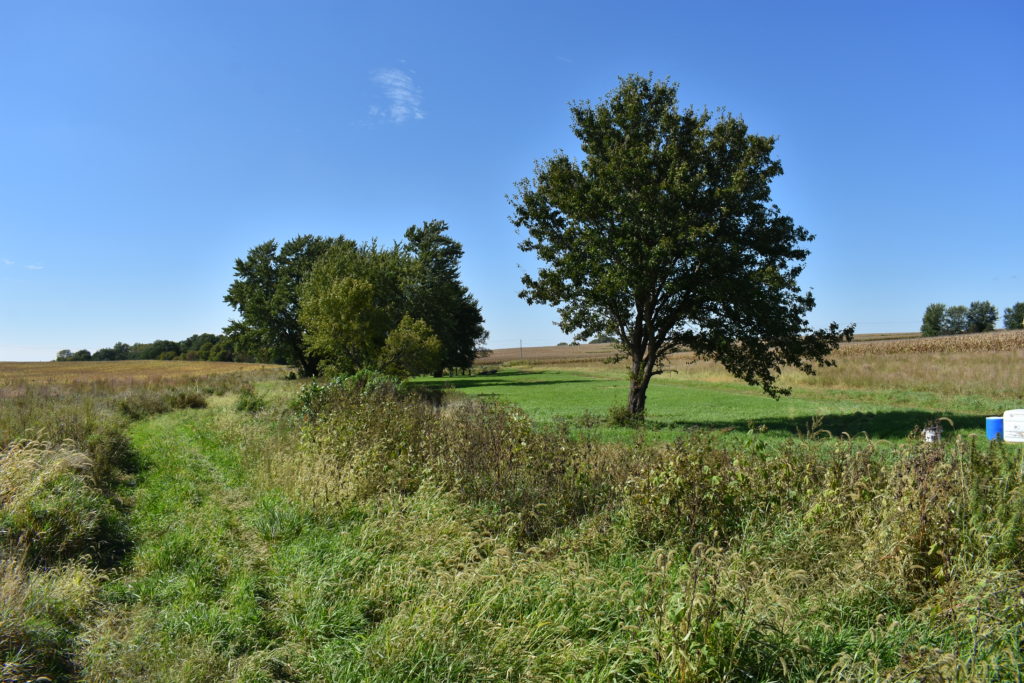
Theory of the Optimal Width
An SRB’s nitrate removal effectiveness, or the ratio of nitrate removed to nitrate received, varies from site to site. The effectiveness depends on the tile flow rate and nitrate load and site conditions such as SRB geometry, soil and geology characteristics and stream conditions. SRB design seeks to maintain an adequate residence time to allow the nitrate to be removed. The greater the SRB width, the more time available to remove nitrate that enters the SRB. However, observed data at six study sites in central Iowa, U.S. indicates that often times the nitrate is completely removed before the water reaches the end of the buffer. In addition, during periods of high flow, untreated drainage bypasses the SRB and discharges to the stream without treatment. While a larger width provides more time for removal, a smaller width results in a greater flow rate in the SRB and therefore a lower nitrate load bypassing treatment.
This tradeoff results in an optimal width; a width that is large enough to remove the nitrate while maximizing the flow rate sent to the SRB. This tradeoff was analyzed using a mass balance that maximizes the nitrate removal effectiveness. In its simplified form, the optimal width L_x^* can be computed as: L_x^*=1.12((K(h_1-h_2))/(n_e λ))^(1/2) where K is the saturated hydraulic conductivity, h1 is the hydraulic head at the distribution pipe, h2 is the hydraulic head at the stream, ne is the effective porosity, and λ is the nitrate removal coefficient (Figure 2).

Case Studies
The optimal width was computed for six existing sites in central Iowa. These sites all treat tile drainage from fields in corn and soybean rotations and are similar in their intended function and monitoring equipment at the site. However, these SRBs vary in width, distribution pipe length, drainage area, topography, tile flow rate and nitrate loads and nitrate removal parameters. The variety of parameters and conditions at these sites means the optimal width also varies by site.
Determining Values of Parameters
The saturated hydraulic conductivity K was determined by performing slug tests using the Hvorslev method.5 The hydraulic head at the distribution pipe h1 is set by the stoplogs in the control structure. The hydraulic head at the stream h2 is monitored. The effective porosity ne was assumed to be equal to values used in previous studies in the watersheds of two of the six study sites.2 Lastly, the nitrate removal coefficient λ was computed using measurements of nitrate concentrations at monitoring wells within the SRBs. Due to the uncertainty in determining these parameters, a 57% uncertainty in the optimal width was computed using relative uncertainties for these four parameters and a first-order uncertainty analysis.
Results and Discussion
For all six study sites, the optimal width is smaller than the current width of the SRB (Figure 3). The current widths at four of the six sites (BC-1, IA-2, B-T, HG) exceed the upper limits of the optimal width ranges and are therefore too wide to remove nitrate most effectively. At these sites, the nitrate concentration falls to zero before the end of the buffer is reached, meaning the buffers could have accommodated more of the tile flow. The effectiveness of these four SRBs would be about 50–120% greater if the width was optimized (Figure 4). The optimal widths of the other two sites (BC-2, SH) fall below the 9.1 m (30 ft) minimum width specified by the USDA-NRCS Code 604.8 Because the upper limit for these two SRBs is also below the minimum width, the optimal width could not have been selected using existing design guidance. However, the current widths for these two SRBs are within the uncertainty ranges for the optimal widths; as a result, they are the closest to maximizing their effectiveness.
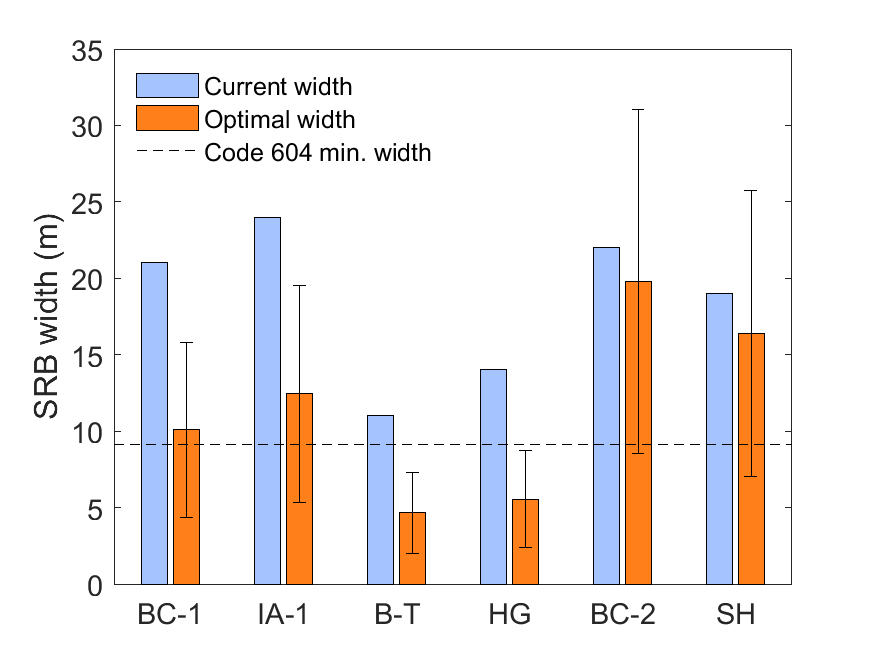

Designing SRBs to be narrower may cause concern related to treating runoff, providing habitat for wildlife, or maintaining stability of the streambank. The width of the riparian buffer can be different than the width of the SRB: the distribution pipe does not need to be placed at the edge of the riparian buffer. Therefore, the riparian buffer and the SRB can both be designed optimally at the same site. In addition, an assessment of five of the six sites analyzed in this study indicated that each site that had a stable width prior to SRB installation remained stable at widths greater than 3 m (9.8 ft).1 SRBs have a minimal impact on a streambank’s stability.
This study shows that SRBs can be designed to remove nitrate more effectively by selecting a width that is within the range of the optimal width for that site. However, challenges remain in applying the optimal width equation to future SRB sites due to uncertain parameters. Future research aimed at developing better ways to predict nitrate removal, saturated hydraulic conductivity and effective porosity is needed in order to more easily apply the optimal width equation.
A more in depth analysis of this study can be found in the Journal of Environmental Quality, Volume 49, Issue 6.7
References
1) Dickey, L. C., McEachran, A. R., Rutherford, C. J., Perez, M. A., Rehmann, C. R., Groh, T. A., Jaynes, D. B. 2020. “Slope stability analysis of saturated riparian buffers.” In Proceedings of the 20th Annual International Erosion Control Association Environmental Connection 20 Conference, Raleigh, NC. Retrieved from https://www.eventscribe.com/2020/IECA/fsPopup.asp?efp=RktZTl
pURlk1NjEz&PresentationID=602788&rnd=0.2624815&
mode=presinfo.
2) Fowle, C. J. 2003. “Application of an analytic element model to understanding groundwater flow and nitrate flux in the Bear Creek watershed in central Iowa” (Master’s thesis). Iowa State University. Retrieved from https://lib.dr.iastate.edu/cgi/viewcontent.cgi?article=
20964&context=rtd.
3) Goolsby, D. A., Battaglin, W. A., Aulenbach, B. T., & Hooper, R. P. 2001. “Nitrogen input to the Gulf of Mexico.” Journal of Environmental Quality. Vol. 30, No. 2, p. 329–336. https://doi.org/10.2134/jeq2001.302329x.
4) Groh, T. A., Davis, M. P., Isenhart, T. M., Jaynes, D. B., & Parkin, T. B. (2019a). “In situ denitrification in saturated riparian buffers.” Journal of Environmental Quality. Vol. 48, No. 2, p. 376. https://doi.org/10.2134/jeq2018.03.0125.
5) Hvorslev, M. J. 1951. “Time lag and soil permeability of groundwater observations (Bulletin 36).” Vicksburg, MS: U.S. Army Corps of Engineers Waterways Experimental Station.
6) Jaynes, D. B., & Isenhart, T. M. 2014. “Reconnecting tile drainage to riparian buffer hydrology for Enhanced nitrate removal.” Journal of Environmental Quality. Vol. 4, No. 2, p. 631–638. https://doi.org/10.2134/jeq2013.08.0331.
7) McEachran, A. R., Dickey, L. C., Rehmann, C. R., et al. 2020. “Improving the effectiveness of saturated riparian buffers for removing nitrate from subsurface drainage.” Journal of Environmental Quality. Vol. 49, No. 6, p. 1–9. https://doi.org/10.1002/jeq2.20160
8) USDA-NRCS. 2016. “Conservation practice standard for saturated buffers: Code 604.” Washington, DC: USDA-NRCS.
About the Expert
Andrea McEachran, M.S., is a full-time graduate engineer at ISG in Des Moines, Iowa. She works on a wide variety of urban and rural water resources projects, often requiring detailed stormwater modeling.
Special thanks to the Iowa Nutrient Research Center for providing funding to complete this research and to all those whose hard work made these findings possible, including but not limited to Chris Rehmann, Loulou Dickey and Kent Heikens.



